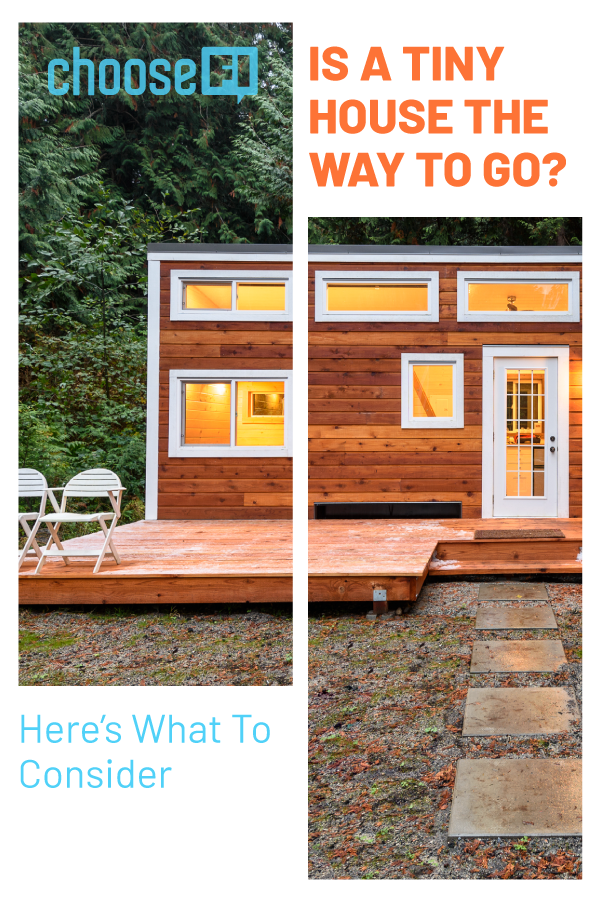Tiny house living has moved from a fringe movement to a trend. It meets the concerns for many who want to simplify their lives, experience homeownership without a mortgage, or take on a new adventure. And with several television shows, magazine covers, and social media glamorizing the lifestyle, taking the plunge might be hard to resist.
One of the main benefits of going tiny, touted by its evangelists, is the large amount of money you can save by living this way. Even though that is possible, you may not see those savings for a long time and it may not be the best option for your situation.
The upfront costs can be pricey, and this movement is evolving quickly. Purchasers are no longer just those who are interested in simplicity and having a smaller carbon footprint. Many experimenters are going bigger and more luxurious with their tiny homes. Many are not interested in DIYing.
According to Mark Stemen, a geography professor who lectures on sustainability and tiny living, “many of these units are now outfitted with stainless-steel appliances, built-in TVs, and elaborate cabinetry.” In some cases, you could be paying almost $200,000 for a tiny home which greatly diminishes the financial benefit.
Tiny house cost of living may make it possible for you to reach Financial Independence more quickly if you consider your financing needs, potential locations, insurance, total cost, and your resale ability.Table Of Contents
- Financing A Tiny House
- Consider Location
- Insurance
- Resale Value
- Utilities And Appliances
- Other Considerations
- Final Thoughts
Financing A Tiny House
The largest percentage of tiny homeowners are over 50 years of age. This is most likely the demographic that chooses to downsize and sell their traditional home. So it would make sense that 68% of tiny homeowners do not have a mortgage, compared to 23% of traditional homeowners. While downsizing homeowners can pay cash with ease, what are the options for those who need to borrow money to build their tiny homes?
Most banks don’t give out mortgages on tiny homes because of their size. Personal loans are the common options for borrowers, but the interest is higher and the terms shorter than a traditional mortgage. The average annual percentage rate on a personal loan ranged from 10% to 28% in 2019. This definitely affects the cost of living in a tiny house.
According to Realtor.com, buyers who purchase more expensive tiny homes, between $70k and $90k, are getting 15 year or 23-year loans for their homes. Some builders offer financing options with banks that are tiny house-friendly such as LightStream, a division of Sun Trust bank.
If you choose to get an RV loan, you will need to have a permanent address to apply since RVs are not considered primary residences. For these loans, the interest rates are higher than a mortgage and require a 20% down payment.
Related: Should You Pay Off Your Mortgage Or Invest?
Consider Location
If you are considering purchasing land, check the zoning ordinances, land use restrictions, and building codes in your area to determine what type of building is permitted. Sometimes, even if the homes are allowed, there can be specific requirements for a building that size.
For example, your loft may be required to have windows and stairs (no ladders) and you may not be allowed to have a stove or plumbing. And the cost of permits could go into the thousands depending on the area.
Similar research is needed for a house on a trailer. First, these tiny homes need to meet the requirements of the Recreational Vehicle Industry Association. Second, many tiny homeowners have run into problems. Local laws don’t always allow a tiny home to be placed in a driveway or yard. There may also be rules regarding how long you can stay on a property or in an RV camping or park area.
RV parks are popular locations for tiny homes and come with varying amenities. You can look at websites like My Tiny House Parking to find areas where you can rent space or find the ever-increasing tiny home communities and villages around the country. Plan on having multiple location options in case one place or another doesn’t work out.
Some areas are changing their ordinances to allow tiny homes, but it is not a fast-moving change for many areas. There is a good chance you will be outside a major city, so other transportation is also an important consideration if you are working in the city or need access to other businesses in populated areas.
Related: How To Create A FI Plan You Can Feel Good About
Insurance
Before you start building, find out if you can get insurance on your tiny house. If so, know the requirements (for example, they may only insure a house built by a professional or that has RV certification).
If you plan on relocating occasionally, you will need to investigate transportation insurance. There is a chance your tiny house may not be insured if you’re towing it yourself. Some people choose to get professional tows because the move is covered under the company’s insurance.
Some other things to get coverage for are for the structure of your tiny home, the property inside it, and liability insurance to ensure you’re protected if someone gets injured on your property.
Resale Value
The land your home is built on is what can increase in value over time. Unfortunately, the price of a tiny home depreciates like a vehicle. It is never quite as valuable as when it is brand new, so you can expect tiny homes to lose their value over time. This is another fact that will affect the cost of living in a tiny house and must be considered.
Sales of tiny homes have risen exponentially since they gained popularity but it is still a very niche market. Because of this there aren’t many buyers and there is a low chance that the interested parties will be local.
And since it is not a typical home, it can’t be listed on the multiple listing service (MLS). This means it won’t be seen on mainstream real estate sites. Tiny House Listings seems to be the go-to website if you are trying to sell. The average tiny home sells for $50k so most buyers prefer a custom build. Why pay top dollar for someone else’s design?
If you have a set place for your tiny house, the best recommendation from realtors is to rent it out. This option offers the best long-term benefit, especially if you are having trouble selling your tiny home.
Utilities And Appliances
On Or Off-Grid?
Unless you are certain you will be living either on or off-grid, your safest bet is to have a home designed for either situation. Make sure you get the correct water, electricity, and sewage hookups so you know what systems you need when designing the house.
Plumbing and wiring can cost an average of $1300 but can be a lot more expensive for off-grid systems.
For self-sustaining utilities, solar panels are the most popular option for power. Prices can go up into tens of thousands depending on the intricacy of the system. A good-sized backup generator is also recommended for times solar isn’t working.
Related: How To Save Money When Buying Appliances
Water
For water, some opt for a tank-and-pump system that separates freshwater, gray water (water from the shower or sink), and black water (wastewater). This system is fairly inexpensive to set up but keep in mind the size of the tanks and how often they will need to be emptied.
A tankless water heater is an expensive purchase which many buyers opt for to provide hot water. Check the warranties on these to make sure it is valid if the water heater is used in a tiny house. Also consider whether you want one that is solar, propane, or electric based on your build.
Another option is a rainwater harvesting system. These systems vary greatly in price depending on the size of the collection tank and all the other individual components. If you choose to go this route, make sure you have a backup source of water available. You never know with the elements and cannot be sure rainwater will always be readily available.
Hooked up to the sewer line because your tiny house is stationary or at an RV park? Then a traditional toilet will work. If you use the tank-and-pump system and must empty your black water, be sure to find out where proper disposal sites are located.
Learn more about the costs of a water collection system.
Composting Toilet?
Many people choose to go with composting toilets, which can cost a few hundred to over a thousand dollars. These toilets collect waste in bags that need to be disposed of with varying frequency. Like the other items we’ve mentioned, the more expensive options offer greater improvements. In this case, some of the pricier composting toilets promise low odor.
The appliances for a tiny home tend to be more expensive because of their size and power source. For example, one tiny home resident recommends getting appliances that run on more than one source of power which comes at a premium.
Keep in mind that while you are saving on monthly bills, more may be required from you in terms of monthly maintenance. Also, with such exclusive products, repairs can be quite costly, and this will also affect the cost of living in a tiny house.
Other Considerations
While your monthly bills will be lower with a tiny home, other factors will affect your finances, time, and comfort. Each of these things will contribute to lowering your cost of living in a tiny house.
Trailer Costs
If your home needs to be towed, then prepare to pay between $400 and $4500 for a trailer. The cost depends on the size of your home. Also, you will need a vehicle able to tow the home, which could be an added expense for some.
Data/Internet Fees
Do you plan to use your data plan as a hotspot? These costs can easily go out of control especially with today’s internet dependence.
Moisture
Tiny homes heat easily and experience moisture issues. You will need a maintenance plan to combat things like recurring mold and temperature control.
Winterization
Your hoses and pipes can freeze if they aren’t properly insulated in winter. Also, since you will need to keep your tiny home warm, a dehumidifier is helpful to combat the moisture buildup.
Food Costs
Because you have less storage for food, that means more trips to the grocery store and consequently a rise in food costs.
Related: 12 Ways To Save Money On Groceries
Final Thoughts
While tiny home sales have increased, many are using the homes as vacation properties or rental homes. This only works if they are permitted to have an accessory dwelling unit (“ADU”) on their property. Many are not considering it a permanent housing solution like most early adapters.
If your goal is to stay in one place, compare the 5-year cost of living tiny to your current situation. The cost is not only financial but there’s your time used for upkeep. Don’t forget the cost of a preferred location and the possible difficulty finding a buyer if you try to sell.
In some cases, it may make more sense to stay put, purchase a condo, or rent a smaller space. Consider that some of the cost of living savings you would get in a tiny home is because of a change in lifestyle. It may end up being more beneficial to change your lifestyle where you are.
Related Articles:




